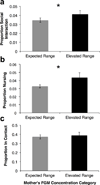Maternal Behavior and Physiological Stress Levels in Wild Chimpanzees (Pan troglodytes schweinfurthii)
- PMID: 26213430
- PMCID: PMC4512756
- DOI: 10.1007/s10764-015-9836-2
Maternal Behavior and Physiological Stress Levels in Wild Chimpanzees (Pan troglodytes schweinfurthii)
Abstract
Individual differences in maternal behavior toward, and investment in, offspring can have lasting consequences, particularly among primate taxa characterized by prolonged periods of development over which mothers can exert substantial influence. Given the role of the neuroendocrine system in the expression of behavior, researchers are increasingly interested in understanding the hormonal correlates of maternal behavior. Here, we examined the relationship between maternal behavior and physiological stress levels, as quantified by fecal glucocorticoid metabolite (FGM) concentrations, in lactating chimpanzees, Pan troglodytes schweinfurthii, at Gombe National Park, Tanzania. After accounting for temporal variation in FGM concentrations, we found that mothers interacted socially (groomed and played) with and nursed their infants more on days when FGM concentrations were elevated compared to days when FGM concentrations were within the range expected given the time of year. However, the proportion of time mothers and infants spent in contact did not differ based on FGM concentrations. These results generally agree with the suggestion that elevated GC concentrations are related to maternal motivation and responsivity to infant cues and are the first evidence of a hormonal correlate of maternal behavior in a wild great ape.
Keywords: Glucocorticoids; Maternal investment; Mother–infant; Stress.
Figures


Similar articles
-
Maternal effects on offspring stress physiology in wild chimpanzees.Am J Primatol. 2018 Jan;80(1). doi: 10.1002/ajp.22525. Epub 2016 Jan 12. Am J Primatol. 2018. PMID: 26757681
-
Rank effects on social stress in lactating chimpanzees.Anim Behav. 2014 Jan;87:195-202. doi: 10.1016/j.anbehav.2013.10.031. Anim Behav. 2014. PMID: 24791015 Free PMC article.
-
Maternal Behavior by Birth Order in Wild Chimpanzees (Pan troglodytes): Increased Investment by First-Time Mothers.Curr Anthropol. 2014 Aug;55(4):483-489. doi: 10.1086/677053. Curr Anthropol. 2014. PMID: 25328164 Free PMC article.
-
Anxiety-related behavior of orphan chimpanzees (Pan troglodytes schweinfurthii) at Gombe National Park, Tanzania.Primates. 2013 Jan;54(1):21-6. doi: 10.1007/s10329-012-0327-1. Epub 2012 Sep 14. Primates. 2013. PMID: 22976111
-
Correlates of maternal glucocorticoid levels in a socially flexible rodent.Horm Behav. 2019 Nov;116:104577. doi: 10.1016/j.yhbeh.2019.104577. Epub 2019 Sep 27. Horm Behav. 2019. PMID: 31442430
Cited by
-
Changes in human health parameters associated with an immersive exhibit experience at a zoological institution.PLoS One. 2020 Apr 17;15(4):e0231383. doi: 10.1371/journal.pone.0231383. eCollection 2020. PLoS One. 2020. PMID: 32302324 Free PMC article.
-
All together now: Assessing variation in maternal and nonmaternal handling of wild Colobus vellerosus infants.Am J Primatol. 2025 Jan;87(1):e23629. doi: 10.1002/ajp.23629. Epub 2024 Apr 23. Am J Primatol. 2025. PMID: 38654439 Free PMC article.
-
Wild Chimpanzee Welfare: A Focus on Nutrition, Foraging and Health to Inform Great Ape Welfare in the Wild and in Captivity.Animals (Basel). 2022 Nov 30;12(23):3370. doi: 10.3390/ani12233370. Animals (Basel). 2022. PMID: 36496890 Free PMC article. Review.
-
Physical and Physiological Indicators of Welfare in Guinea Pigs (Cavia porcellus) Serving as Ambassador Animals.Animals (Basel). 2020 May 8;10(5):815. doi: 10.3390/ani10050815. Animals (Basel). 2020. PMID: 32397191 Free PMC article.
-
The Gombe Ecosystem Health Project: 16 years of program evolution and lessons learned.Am J Primatol. 2022 May;84(4-5):e23300. doi: 10.1002/ajp.23300. Epub 2021 Jul 5. Am J Primatol. 2022. PMID: 34223656 Free PMC article. Review.
References
-
- Adamakos H, Ryan K, Ullman DG, Pascoe J, Diaz R, Chessare J. Maternal social support as a predictor of mother-child stress and stimulation. Child Abuse & Neglect. 1986;10(4):463–470. - PubMed
-
- Albers EM, Riksen-Walraven JM, Sweep FCGJ, de Weerth C. Maternal behavior predicts infant cortisol recovery from a mild everyday stressor. Journal of Child Psychology and Psychiatry. 2008;49(1):97–103. - PubMed
-
- Altmann J. Observational study of behavior: Sampling methods. Behaviour. 1974;49:227–266. - PubMed
-
- Bahr NI, Pryce CR, Döbeli M, Martin RD. Evidence from urinary cortisol that maternal behavior is related to stress in gorillas. Physiology & Behavior. 1998;64(4):429–437. - PubMed
-
- Bardi M, Bode AE, Ramirez SM, Brent LY. Maternal care and development of stress responses in baboons. American Journal of Primatology. 2005;66(3):263–278. - PubMed
Grants and funding
LinkOut - more resources
Full Text Sources
Other Literature Sources
Research Materials
Miscellaneous
